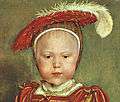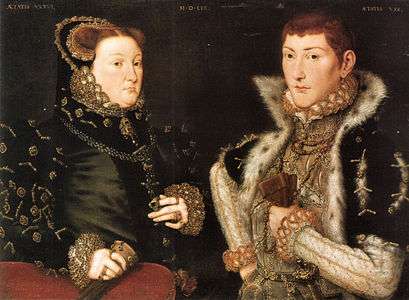Aiguillette (ornament)

An aiguillette, aguillette or aiglet (from French aiguille "needle") is a decorative tag or tip for a cord or ribbon,[1] usually of gold and sometimes set with gemstones or enameled. Small cords and ribbon bows tipped with pairs of aiguilettes were fashionable ornaments in the 16th and early 17th centuries.[2]
In contemporary military and civil uniforms, an aiguillette is an ornamental braided cord with a similar metal tip, derived from armor fastenings. The plastic or metal aglet on a shoe lace is also a direct descendant.
Uses


Aiguillettes were made in sets, and might be of silver, silver-gilt, or gold.[2]
Surviving portraits show that aiguillettes could be functional or purely decorative, though many were used to "close" seams and slashes[2] that are not always apparent on dark garments in portraits. They were made in matched sets and were worn in masses. The Day Book of the Wardrobe of Robes of Elizabeth I of England records items given and received into storage, including details of buttons and aiguillettes lost from the Queen's clothing:
Lost the 2 of February ... [1582] 1 bunsh of small gold tagges or aglettes from a gowne of black satten at Sittingbourne parcell [part] of uppon the same gowne 193 bunshes[4]
Elizabeth's aiguillettes were variously enameled with white, red, black, blue, and purple details or set with diamonds, garnets, rubies, and pearls;[2][5] those of Anne of Denmark in the early years of the 17th century were larger, shaped in triangles and pyramids. One set of 24 were made three-sided, with "27 diamonds in the sides and one in the top", for a total of 642 diamonds in the set.[2]
Gallery
-

The future Edward VI of England wears a hat and gown trimmed with pairs of aiguillettes, 1538
-

Mary Nevill and her son, Gregory Fiennes, Baron Dacre wear gowns decorated with gold aiguilettes, 1559
-

Elizabeth of Valois, Queen of Spain, wears rose ribbons tipped with large aiguillettes set with pearls, c. 1560s
-

Charles I of England wears a doublet and hose with ribbon points tipped with aiguillettes, 1630s
See also
Notes
- ↑ Picken, Mary Brooks: The Fashion Dictionary, p.4
- 1 2 3 4 5 Scarisbrick, Diana, Tudor and Jacobean Jewellery, London, Tate Publishing, 1995, p. 97
- ↑ Detail of Portrait of Gregory Fiennes, Baron Dacre by Hans Eworth, 1559
- ↑ Arnold, Janet, Lost from Her Majesties Back, p.74
- ↑ Arnold, Janet, Lost from Her Majesties Back
References
- Arnold, Janet: Lost from Her Majesties Back, the Costume Society, 1980. (Items of clothing and jewels lost or given away by Elizabeth I between 1561 and 1583, entered in one of the day books kept for the records of the Wardrobe of Robes.)
- Arnold, Janet: Patterns of Fashion: the cut and construction of clothes for men and women 1560–1620, Macmillan 1985. Revised edition 1986. ISBN 0-89676-083-9
- Arnold, Janet: Queen Elizabeth's Wardrobe Unlock'd, W S Maney and Son Ltd, Leeds 1988. ISBN 0-901286-20-6
- Picken, Mary Brooks: The Fashion Dictionary, Funk and Wagnalls, 1957. (1973 edition ISBN 0-308-10052-2)
- Hearn, Karen, ed. Dynasties: Painting in Tudor and Jacobean England 1530–1630. New York: Rizzoli, 1995. ISBN 0-8478-1940-X.
- Scarisbrick, Diana, Tudor and Jacobean Jewellery, London, Tate Publishing, 1995, ISBN 1-85437-158-4